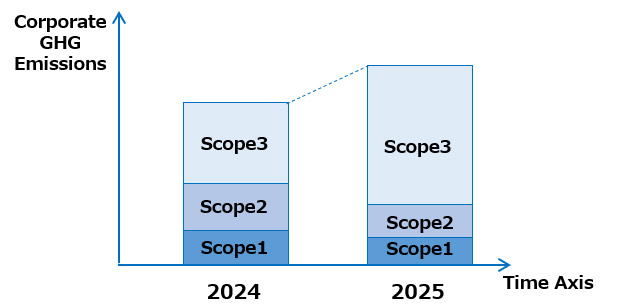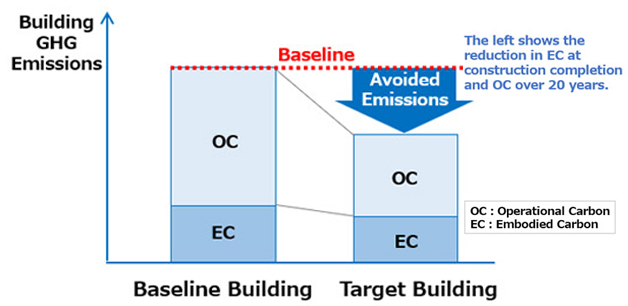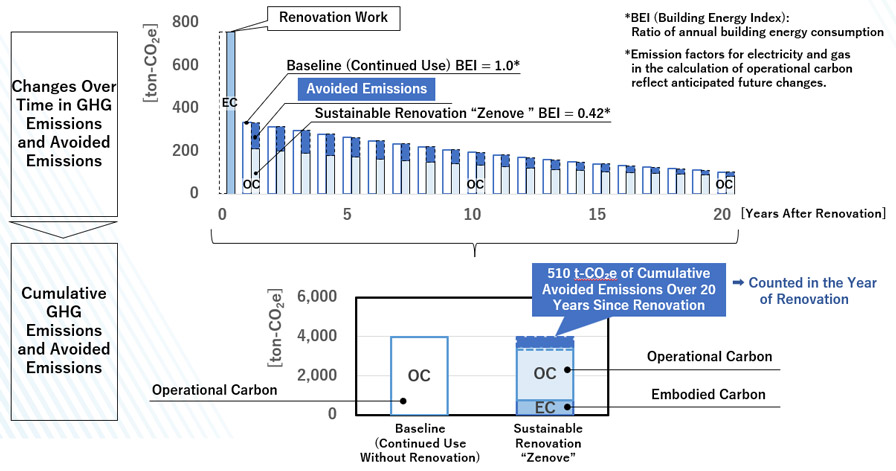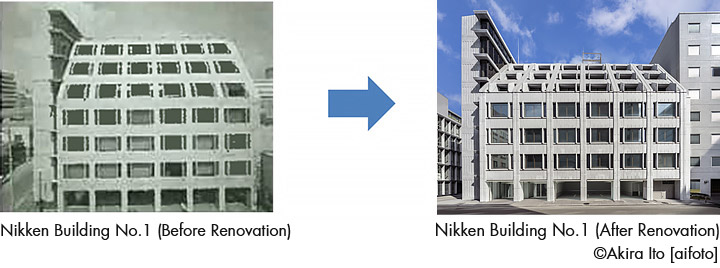Proposal for a Draft Methodology for Measuring Avoided Greenhouse Gas Emissions in the Built Environment Sector
Aiming Towards the World’s First Industry Standard Guidelines as a Future Investment Benchmark, Reflecting Broad Stakeholder Input Including the Financial Sector
Nikken Sekkei Ltd. (Head Office: Chiyoda City, Tokyo; President: Atsushi Omatsu) proposed the establishment of the “Committee on Guidelines for Measuring Avoided Emissions in the Built Environment Sector” in June 2024 comprising external experts and stakeholders, and has now presented its outcome as a draft methodology for measuring avoided emissions. This initiative aims to introduce the world’s first draft guidelines on avoided emissions for the built environment sector, thereby facilitating the acceleration of the GX (Green Transformation: decarbonization) market in these fields.
“Avoided Emissions” Gain Attention as an Investment Criterion: Guideline Development Lags in the Built Environment Sector Despite Growing Interest
As corporate efforts to reduce greenhouse gas (GHG) emissions increasingly become a key investment criterion, companies are striving to minimize CO2 emissions across Scope 1 to 3. Meanwhile, avoided emissions are gaining attention as a new metric for evaluating a company’s capacity to reduce GHG emissions. Avoided emissions refer to the difference in GHG emissions between the baseline scenario with the traditional goods and services and the proposed solution provided by the new alternatives.
At COP29 in November 2024, the World Business Council for Sustainable Development (WBCSD) announced plans to consider adopting avoided emissions under the GHG Protocol, while various industries are progressing in the development of guidelines for measuring avoided emissions.
At COP29 in November 2024, the World Business Council for Sustainable Development (WBCSD) announced plans to consider adopting avoided emissions under the GHG Protocol, while various industries are progressing in the development of guidelines for measuring avoided emissions.
-
 Conventional evaluation method using Scopes 1-3 GHG emissions
Conventional evaluation method using Scopes 1-3 GHG emissions
-
 Concept of Avoided Emissions
Concept of Avoided Emissions
Meanwhile, in the built environment sector, measuring avoided emissions has been highly complex due to factors such as the large number of stakeholders involved in building construction and operation, the longer service life compared to consumer products, the occurrence of renovations, the prevalence of leasing arrangements without a sale, and the dual nature of real estate as both a product and a one-off project. Consequently, the development of guidelines has been delayed.
 Differences Between Building Construction/Real Estate and Consumer Products
Differences Between Building Construction/Real Estate and Consumer Products
*Embodied carbon: Carbon emissions associated with the production of building materials, new construction, renovation, and demolition.
*Operational carbon: Carbon emissions resulting from energy and water use during the operation of a building.
Proposal to Establish a Committee for Decarbonization Promotion and Presentation of a Draft Methodology for Measuring Avoided Emissions
Nikken Sekkei has contributed to the development of whole life carbon measurement tools for buildings, leveraging its neutrality as an architectural design firm. To further promote decarbonization in the built environment sector by attracting investment in companies contributing to emissions reduction, Nikken Sekkei proposed and established the “Committee on Guidelines for Measuring Avoided Emissions in the Built Environment Sector” in June 2024, recognizing the need for a unified industry-wide framework for evaluating avoided emissions. With participation from financial sector representatives who will apply this framework in their investment strategies, alongside building construction and real estate stakeholders, the committee held multiple discussions. In June 2025, the “Draft Methodology for Measuring Greenhouse Gas Avoided Emissions in the Built Environment Sector,” was developed and proposed to relevant industries and government ministries. This represents the world’s first draft of its kind in the sector.
The draft outlines the concept and methodology for measuring avoided emissions in this sector. It is expected to facilitate proper evaluation and promote informed investment decisions by financial institutions, thereby contributing to CO₂ reduction across the entire industry.
The committee will continue its activities in fiscal 2025, working to transform the draft—an outcome of this voluntary initiative—into guidelines that serve as an industry standard, incorporating input from diverse range of stakeholders. Discussions on avoided emissions are expected to progress, with active deliberations anticipated in forums such as the Zero Carbon Building (LCCO₂ Net Zero) Promotion Council organized by the Institute for Built Environment and Carbon Neutral for SDGs (IBECs). We will continue to closely monitor these developments.
The draft outlines the concept and methodology for measuring avoided emissions in this sector. It is expected to facilitate proper evaluation and promote informed investment decisions by financial institutions, thereby contributing to CO₂ reduction across the entire industry.
The committee will continue its activities in fiscal 2025, working to transform the draft—an outcome of this voluntary initiative—into guidelines that serve as an industry standard, incorporating input from diverse range of stakeholders. Discussions on avoided emissions are expected to progress, with active deliberations anticipated in forums such as the Zero Carbon Building (LCCO₂ Net Zero) Promotion Council organized by the Institute for Built Environment and Carbon Neutral for SDGs (IBECs). We will continue to closely monitor these developments.
About Avoided Emissions
・Difference from Conventional GHG Emission Indicators (Scope 1, 2, and 3)
Scopes 1–3 are measured based on a company’s actual emission data. In contrast, avoided emissions are measured by comparing them with a modelled baseline scenario. In the built environment sector, the basic unit of assessment is a building. Rather than assessing the baseline building, the method focuses on the positive contribution of avoided emissions achieved through the construction of the subject building. This approach allows for the evaluation of how the company responsible for the building contributes to the overall reduction of emissions in society.
For instance, the construction of a building that achieves reduced GHG emissions during both the construction and operational phases may lead to an increase in a company’s Scope 1–3 emissions compared to maintaining the status quo of not constructing the building. However, by quantifying the reduced GHG emissions as avoided emissions, the value of these reduction efforts can be effectively recognized and highlighted.
・Existing Guidelines on Avoided Emissions
Internationally, WBCSD, and in Japan, the Ministry of Economy, Trade and Industry, the Institute of Life Cycle Assessment, Japan, and the GX League’s GX Management Promotion Working Group have issued guidelines and basic policies on avoided emissions. In sectors such as chemicals, electronics, and gas, industry-specific guidelines for measuring avoided emissions already exist. This draft has been developed with reference to these existing guidelines while considering the specific characteristics of the built environment sector.
Scopes 1–3 are measured based on a company’s actual emission data. In contrast, avoided emissions are measured by comparing them with a modelled baseline scenario. In the built environment sector, the basic unit of assessment is a building. Rather than assessing the baseline building, the method focuses on the positive contribution of avoided emissions achieved through the construction of the subject building. This approach allows for the evaluation of how the company responsible for the building contributes to the overall reduction of emissions in society.
For instance, the construction of a building that achieves reduced GHG emissions during both the construction and operational phases may lead to an increase in a company’s Scope 1–3 emissions compared to maintaining the status quo of not constructing the building. However, by quantifying the reduced GHG emissions as avoided emissions, the value of these reduction efforts can be effectively recognized and highlighted.
・Existing Guidelines on Avoided Emissions
Internationally, WBCSD, and in Japan, the Ministry of Economy, Trade and Industry, the Institute of Life Cycle Assessment, Japan, and the GX League’s GX Management Promotion Working Group have issued guidelines and basic policies on avoided emissions. In sectors such as chemicals, electronics, and gas, industry-specific guidelines for measuring avoided emissions already exist. This draft has been developed with reference to these existing guidelines while considering the specific characteristics of the built environment sector.
Overview of the Draft Methodology for Measuring Avoided Greenhouse Gas Emissions in the Built Environment Sector
| 1. | Eligibility Criteria:Requirements for both “Corporate Eligibility” and “Solution Eligibility” are defined. | |
|---|---|---|
| 1) | It specifies that energy efficiency, resilience, and wellness performance of real estate must not be compromised. | |
| 2. | Measuring Methodology for Avoided Emissions:“Quantification Target,” “Baseline Setting,” “Assessment Scope,” and “Measuring Approach” are defined. | |
| 1) | Quantification Target:This target focuses on avoided emissions throughout the life cycle of real estate in cases of new construction or renovation, encompassing both operational carbon and embodied carbon. Baseline and solution measurements are conducted using tools such as J-CAT®. (J-CAT® is a registered trademark of the Institute for Built Environment and Carbon Neutral for SDGs.) | |
| 2) | Baseline Setting:For new construction, the baseline is defined as a conventional property; for renovation, it is defined as the continued use of the property without renovation. Further discussion will be required to define the details. | |
| 3) | Assessment Scope:For new construction, the scope covers the construction and in-use phases of the property. For renovation, it encompasses the renovation and in-use phases until the next renovation. In both cases, the demolition phase is excluded. The assessment period is set at 20 years, assuming the duration from new construction or renovation until the next renovation. | |
| 4) | Measuring Approach: In principle, a forward-looking approach is recommended for properties for sale , which records the total avoided emissions, including future periods, at the time of completion. For rental properties, a year-on-year approach that reflects actual annual results is considered appropriate. As there is currently no internationally agreed-upon concept regarding contribution rates, this topic is not addressed in this draft and will remain a subject for further discussion. | |
| 3. | Corporate-Level Avoided Emissions:When measuring avoided emissions at the company level, all solutions implemented by the company within the year, including those resulting in negative avoided emissions, must be aggregated for evaluation. | |
| 4. | Verification and Reporting:It is recommended that the measurement results undergo third-party verification, including internal assessments. Additionally, it is essential to clearly state whether verification has been performed, and if applicable, to disclose the identity of the verifier along with the details of the verification process. | |
Examples of Measuring Avoided Emissions
Renovation of Nikken Building No.1 (2025):
This project achieved ZEB Ready (50% energy reduction standard) certification through “Zenove” (Zero-Energy Building Renovation), an environmental retrofit that incorporates widely applicable technologies such as LED lighting, HVAC efficiency improvements, and improved insulation for a 57-year-old building. The estimate shows 510 t-CO₂e of avoided emissions over 20 years by limiting embodied carbon to 760 t-CO₂e and reducing operational carbon by 1,270 t-CO₂e through the use of low-carbon concrete, electric arc furnace steel, and low-GWP refrigerants. The avoided emissions would be even greater if the baseline comparison were made against demolition and new construction instead of renovation.
This project achieved ZEB Ready (50% energy reduction standard) certification through “Zenove” (Zero-Energy Building Renovation), an environmental retrofit that incorporates widely applicable technologies such as LED lighting, HVAC efficiency improvements, and improved insulation for a 57-year-old building. The estimate shows 510 t-CO₂e of avoided emissions over 20 years by limiting embodied carbon to 760 t-CO₂e and reducing operational carbon by 1,270 t-CO₂e through the use of low-carbon concrete, electric arc furnace steel, and low-GWP refrigerants. The avoided emissions would be even greater if the baseline comparison were made against demolition and new construction instead of renovation.


Impact on Investment Decisions
In October 2024, Mizuho Financial Group, Inc., and in March 2025, Nomura Holdings, Inc. released reports on avoided emissions, reflecting the growing interest in utilizing avoided emissions for corporate evaluation and investment decisions within the financial sector.
By updating this draft into an industry-standard guideline incorporating feedback from a broad range of stakeholders, including not only the built environment sector but also the financial sector, it is anticipated that appropriate asset valuation and informed investment decisions will be promoted for building construction and real estate companies, ultimately leading to CO₂ reduction across the entire sector.
By updating this draft into an industry-standard guideline incorporating feedback from a broad range of stakeholders, including not only the built environment sector but also the financial sector, it is anticipated that appropriate asset valuation and informed investment decisions will be promoted for building construction and real estate companies, ultimately leading to CO₂ reduction across the entire sector.
<Comment from Hayato Tsuji, General Manager, Asset Finance Department, Development Bank of Japan Inc. (Guideline Committee Member)>
As GHG emission measurement and disclosure expand to include the supply chain (Scope 3), we view “avoided emissions” as a key concept that supports decarbonization efforts while reinforcing companies’ sound business activities and industrial competitiveness, as well as maintaining and updating the necessary social overhead capital.
In the financial sector, “avoided emissions” are gaining attention from financial institutions and investors as a key indicator for assessing climate-related opportunities and risks associated with investee companies, as well as for impact investment and sustainable finance. In the “Zero-Energy Building Renovation Project (Zenove),” in which our bank also participates, we are measuring avoided emissions in actual real estate fund investments, aiming to balance improved environmental performance of existing buildings with investment returns. We believe that the release of this draft will enhance the clarity of methods and approaches for measuring avoided emissions in the built environment sector, making a significant contribution to society’s decarbonization efforts.
As GHG emission measurement and disclosure expand to include the supply chain (Scope 3), we view “avoided emissions” as a key concept that supports decarbonization efforts while reinforcing companies’ sound business activities and industrial competitiveness, as well as maintaining and updating the necessary social overhead capital.
In the financial sector, “avoided emissions” are gaining attention from financial institutions and investors as a key indicator for assessing climate-related opportunities and risks associated with investee companies, as well as for impact investment and sustainable finance. In the “Zero-Energy Building Renovation Project (Zenove),” in which our bank also participates, we are measuring avoided emissions in actual real estate fund investments, aiming to balance improved environmental performance of existing buildings with investment returns. We believe that the release of this draft will enhance the clarity of methods and approaches for measuring avoided emissions in the built environment sector, making a significant contribution to society’s decarbonization efforts.
Committee Members of the “Committee on Guidelines for Measuring Avoided Emissions in the Built Environment Sector”
| Member List | ||
|---|---|---|
| Academic Experts | Toshiharu Ikaga | Professor Emeritus, Keio University |
| Shinichi Tanabe | Professor, School of Creative Science and Engineering, Faculty of Science and Engineering, Waseda University | |
| Mari Yoshitaka | Visiting Professor, College of Arts and Sciences, The University of Tokyo; Specially Appointed Professor, Faculty of Policy Management, Keio University; Representative Director, Virtue Design Association | |
| Committee Members | Ryota Ii | General Manager, GX Promotion Department, Social Innovation Division, Pacific Consultants Co., Ltd. |
| Toshiyuki Inoue | Executive Managing Officer, Urban Development Promotion Department, Urban Energy Strategy Planning Department, Marunouchi Development Department, and TOKYO TORCH Department, Mitsubishi Estate Co., Ltd. | |
| Kunihiko Kitayama | Managing Executive Officer, Head of Social & Industrial Infrastructure Group, Mizuho Bank, Ltd. | |
| Kazuma Koyama | Senior Manager, External Relations Department, Tokyo Office, In charge of CSR and Global Environment, Daikin Industries, Ltd. | |
| Masafumi Sekine | Executive Officer, Principal of DX and GX Center, Nikken Sekkei Ltd. | |
| Hayato Tsuji | General Manager, Asset Finance Department, Development Bank of Japan Inc. | |
| Ryuichi Horie | Co-founder and CEO, CSR Design Green Investment Advisory, Co., Ltd. | |
| Yu Yamamoto | General Manager, Sustainability Promotion Department, Mitsui Fudosan Co., Ltd. | |
| Yoshitake Yoshimura | Deputy General Manager, Environmental Engineering Division and Director, Global Environment Office, Kajima Corporation | |
| Observers | Masashi Kawano | Executive Officer, Nikken Sekkei Research Institute |
| Susumu Horikawa | Senior Director, Nikken Sekkei Ltd. | |
| Secretariat | Yoshiko Ogami | Associate, Building Services Design Group, Engineering Department, Nikken Sekkei Ltd. |
| Katsumi Niwa | Director, Sustainability Promotion Office, DX and GX Center, Nikken Sekkei Ltd. | |
| Megumi Horii | Associate, Sustainability Promotion Office, DX and GX Center, Nikken Sekkei Ltd. | |
| Hiroyuki Uchida | Principal, Sustainability Consulting Division 1, Mizuho Research & Technologies, Ltd. | |
| Riku Kawamoto | Senior Consultant, Sustainability Consulting Division 1, Mizuho Research & Technologies, Ltd. | |
| Maiko Sugimura | Senior Consultant, Sustainability Consulting Division 1, Mizuho Research & Technologies, Ltd. | |
| Kentaro Noguchi | Senior Consultant, Sustainability Consulting Division 1, Mizuho Research & Technologies, Ltd. | |
| Miki Yamane | Senior Consultant, Sustainability Consulting Division 1, Mizuho Research & Technologies, Ltd. | |
About Nikken Sekkei
Nikken Sekkei is a professional services firm engaged in architectural and civil engineering design and supervision, urban design and related research, planning, and consulting services. Since its founding in 1900, Nikken Sekkei has been creating value through “social environmental design,” addressing both explicit and latent social challenges to meet the needs of society and clients for over 120 years. We have been involved in various projects across Japan, China, ASEAN, and the Middle East, as well as India and Europe in recent years.
Contact for Inquiries
Nikken Sekkei Ltd
Corporate Communications Dept.
TEL: +81-3-5226-3030 (Main)
E-mail: webmaster@nikken.jp
Corporate Communications Dept.
TEL: +81-3-5226-3030 (Main)
E-mail: webmaster@nikken.jp